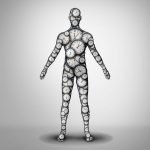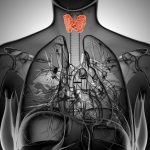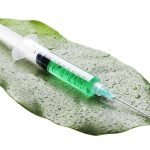Treating Allergies and Autoimmunity in Children: A Gastrointestinal-Based Approach
Kären van der Veer, ND
From the beginning of our naturopathic education we are immersed in the concept of treating the gut as a foundational form of healing intervention. There simply is no getting around the central role that the gastrointestinal (GI) tract plays in the entire scope of human physiology.
Treating children and adults with allergies or autoimmune conditions is no exception to this time-honored wisdom. I currently have a general practice and see patients of all ages and states of health, but have developed a “specialty” to a large extent in GI issues. I also have a practice that specializes in pregnancy, postpartum and children’s health. While both adults and children alike can benefit from the same treatment approach to allergies or autoimmunity, I will focus here on pediatric concerns.
In my practice I have used almost identical approaches to both allergies and autoimmunity. I feel strongly that in both situations the body is overwhelmed by a combination of environmental, toxic and/or antigenic load and thus begins to express pathological symptoms. In approaching my pediatric patients with allergies or autoimmune disease, I generally use 5 treatment objectives and focus heavily on GI intervention.
Treatment Objectives
The following are my treatment objectives:
1) Elimination of environmental toxins
2) Dietary detoxification and the reduction of antigenic load
3) Specific GI healing and support
4) Reduction of systemic inflammation
5) Complete nutritional support
Elimination of Environmental Toxins
Treating the allergic or autoimmune child, I certainly begin by removing the obstacles to cure…or at least removing as many obstacles as possible. This can include removing environmental obstacles (toxic environmental influences of all kinds from chemicals and perfumes to mold and sources of dust accumulation…carpets and the like). It may also be necessary to include the removal of heavy metals through a more intensive detoxification. I spend much of my time in a patient visit discussing the various environmental challenges to a child’s health and how these can be eliminated or mitigated.
Dietary Detoxification
After addressing issues with one’s physical surroundings and exposure, dietary intervention is the cornerstone of most of my treatment plans, beginning with some form of cleansing and detoxifying diet. Although this can be even more of a challenge to accomplish with children than adults, it is a completely worthwhile and necessary approach to take.
To determine specific foods which are a challenge to the system, elimination and reintroduction is the gold standard, and I find the shortcuts of serological allergy tests infuriatingly inaccurate and oftentimes misleading. After eliminating or rotating the most common allergenic foods (wheat, dairy, corn, soy and eggs) out of the diet, I usually see enough improvement in the allergies or autoimmune symptoms to easily persuade the parent (and the child) to continue with a healthier, less-allergenic diet. Moving to an organic whole foods diet free of the most commonly allergenic foods as well as artificial preservatives, flavorings, and colorings, makes room for the consumption of a greater quantity and variety of organic fruits and vegetables. All of these changes contribute to decreasing inflammation systemically.
For many patients, greater dietary “specificity” produces even greater results when items such as gluten, grains in general, nuts, legumes, citrus, nightshades and any suspicious foods are tested with elimination and reintroduction. As we know, every patient is unique and we must prepare both parent and child for the patience that this process may take. Sometimes it may take as long as 6 months to a year of elimination and reintroduction to fine tune the diet to a place of optimal wellness. I take it slowly, especially with children. This is an invaluable approach, but one which may require considerable hand-holding and dietary counsel. The results of a healthy child thriving and happy with improved physical and emotional well-being are well worth the effort.
Gastrointestinal Healing and Support
Specific GI support and healing can produce results that are nearly as dramatic as dietary detoxification. I have tried implementing them separately, together and in series. I get the best results when I do them together. Depending on the patient and their specific GI symptoms, the approach can vary.
I use some combination of the following supplements in my attempts to specifically nourish and heal gut function:
- Probiotic Powder: to recolonize the beneficial microbes. It is important to use a wide-spectrum, proven and reputable source.
- Glutamine: the primary fuel for enterocytes as well as most cells of the immune system, including macrophages and lymphocytes.
- Larch Arabinogalactans: a source of fiber and the primary fuel for beneficial microorganisms, which are then converted to short-chain fatty acids, the primary fuel for colonocytes. Larch also supports immune function by increasing NK cell function. It has the added benefit of helping to bind unfavorable lectins, thus reducing the antigenic burden to the body. (a very important aspect in addressing both allergies and autoimmunity)
- DGL powder: for use when the gut seems apparently irritated. Slippery elm powder could also be used for the purpose of soothing the G.I. tract, although I believe it to have somewhat less intense effects.
- Quercetin powder: as a powerful anti-inflammatory that seems to have many G.I.-specific benefits.
- Glycine powder: as needed to sweeten the powder combination and make it more palatable.
I use these products in powder form in varying combination and ratios depending on the specific symptoms of the patient. Once combined I have the patient refrigerate and then add the powder to water or dilute juice and I often have them add in some elderberry extract for its flavor and added anti-inflammatory and immune benefits.
I most commonly have the child take this G.I. drink two to three times daily at the beginning and possibly taper to once daily when symptoms have resolved or are in remission.
4) Reduction of systemic inflammation is initiated by the G.I. formula which can often do wonders in reducing overall inflammation.
Other important players in the reduction of systemic inflammation are fish oil, antioxidants (in all their forms from food to herbs to orthomolecular supplementation) and Vitamin D3. There are liquid forms of antioxidants (including vitamins A and E) and Vitamin D3 and in some cases pills can be taken apart and emptied into the mouth. Vitamin D3 has a sour taste and I have found many children will even prefer the powder emptied into their mouths versus the drops. Vitamin C can be taken in pill, chewable tablet or powder form. There are many vitamin C powders available, some of which are combined already with other antioxidants such as Quercetin. Zinc is an important antioxidant for the reduction of inflammation and can be taken in a chewable tablet or liquid form for children. It is critical to give a weight and age-appropriate dose.
So very important to the reduction of inflammation is the consumption of a proper balance and adequate dosage of Omega 3 fatty acids. Fish oil is an absolutely indispensable supplement in the treatment of allergies and autoimmunity. A superior-quality lemon-flavored liquid fish oil works great with the pediatric population and I have always found this to be an easy supplement for the children in my practice, much to the surprise of their parents. In fact, children generally prefer a simple citrus-flavored oil to those that are combined with complex extracts or flavorings. The dose of EFA’s in small chewable gummies or pearls simply provides an inadequate daily dose, which is why I believe that the liquid fish oils are the way to go. Dosage should be based on weight and age but should be on the generous end of the scale.
A final note about the use of any liquid or powder or chewable medication with your pediatric patients: Never fail to taste the products that you are prescribing, yourself. This is essential to being an authority on the supplements you prescribe and essential to patient compliance.
5) Finally, we must ensure that all of the nutritional bases are covered in addressing the allergenic or autoimmune pediatric patient. Certainly with improved diet and better GI function, nutritional status will improve dramatically. We must also make sure that we provide a full web of support for the patient, in addition to EFA’s and antioxidants in the form of abundant B vitamins and trace minerals. This can be accomplished with a good quality multi-vitamin and mineral. Pre-made powders and liquids are available but you may also use capsules for older children or empty the contents of the capsules into dilute juice or smoothies for the younger population.
Although executing the entire treatment plan may require patience and a true commitment from the pediatric patient and their parents, everyone involved will find it worth the effort. I have found this approach most often to be curative and to establish a long term course towards more abundant health. In addition, the consciousness-raising that occurs during this process reaps long term benefits for all members of the family and can potentially change the course of every individual’s health.
For me the rewards of addressing allergies and autoimmunity in the pediatric population holds in it the gift of knowing that you have helped to change the course of that person’s life, from its early stages and provide some insurance that their health challenges down the road will be considerably less.
Case study
The patient is a 10-yr-old male, “Joshua”, with history of food and seasonal allergies, eczema, asthma, irritable bowel with predominant constipation. All labs are WNL. Patient is not + for celiac. Eczema, intermittently since approx 6 months of age. Breastfed for first 4 months of life. Predisposition to hard stool since termination of breastfeeding. Joshua eats a “healthy version” of the standard American diet: lots of pasta, cheese and other wheat and dairy products, but also consumes a good variety of fruits and vegetables.
TREATMENT PLAN
Dietary
Complete elimination of wheat and dairy. Whole foods organic diet. Rotation or elimination/reintroduction of other allergenic foods including corn, soy and eggs. Diet and symptom diary to record any reactions to foods. Extensive dietary counseling to guide and support changes for patient and the whole family.
GI Support
Comprehensive probiotic powder: ½ tsp qd for the first week, then bid for 3 months. Reduced to qd when symptoms improved dramatically.
The following powders were combined and 1 heaping tsp was taken in applesauce, smoothie, or dilute juice tid for 3 months, then reduced to bid for 6 months and eventually to qd.
- Larch arabinogalactans: 1 cup of powder
- Glutamine: 1 cup of powder
- DGL: ½ cup of powder
- Quercetin: ¼ cup of powder
- Glycine: ½ cup of powder
General Nutritional Support
- Children’s multivitamin and mineral 2 caps bid
- Liquid fish oil: 1 tsp qd
- Vitamin D3: 5,000 IU 3 days per week
- Buffered C powder with added minerals and antioxidants: 1 tsp qd in smoothie or dilute juice
Follow-Up
Joshua’s GI function normalized within the first week of wheat and dairy elimination and the introduction of the G.I. support formulation and probiotics. The changes in his bowel habits were quite dramatic and rapid. He found with any reintroduction of wheat products that constipation and alternating constipation and loose stool would return. When he skipped the probiotic powder he also noticed the return of some of his symptoms.
The eczema resolved within about 10 days of the implementation of the dietary changes, G.I. and nutritional support.
Inhaler use was decreased in the first month following our visit by about 50%. Within 6 months, he rarely needed the inhaler and had decreased use to less than twice per month.
Incidentally mood, sleep and attention improved and Joshua’s mother reported that he was generally more at ease with himself and others and more even-tempered. His attention in school improved and he is feeling happier.
Joshua maintains the general nutritional support, and takes the G.I. formula 3-7 times per week. He continues to take the probiotics once daily. He maintains a wheat and cow dairy-free diet and feels even better when he avoids gluten in general. He seems to tolerate goat dairy well, about 3-5x per week. Soy is tolerated in moderation, as well—only about twice per week. Corn is aggravating to the eczema and possibly the asthma, but does o.k. with organic blue corn products. He has greatly increased his fatty acid consumption in the form of seeds, some nuts, olive and coconut oils. He feels better, emotionally, with less moodiness and more energy, when he has a greater amount of healthy fats in his diet.
 Kären van der Veer, ND is the mother or two gloriously healthy and happy children. She is also the founder of My Naturally Well Baby (MyNaturallyWellBaby.com) a natural health resource for pregnancy, postpartum and childhood. Originally, a devoted HIV specialist, Dr. van der Veer has focused for the past 5 years on maternal and childhood health in addition to maintaining a general Naturopathic practice. She is a 1998 graduate of SCNM and has served as adjunct faculty there since 2000. She can be reached at 602. 502. 1122 or through MyNaturallyWellBaby.com.
Kären van der Veer, ND is the mother or two gloriously healthy and happy children. She is also the founder of My Naturally Well Baby (MyNaturallyWellBaby.com) a natural health resource for pregnancy, postpartum and childhood. Originally, a devoted HIV specialist, Dr. van der Veer has focused for the past 5 years on maternal and childhood health in addition to maintaining a general Naturopathic practice. She is a 1998 graduate of SCNM and has served as adjunct faculty there since 2000. She can be reached at 602. 502. 1122 or through MyNaturallyWellBaby.com.










